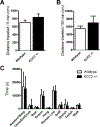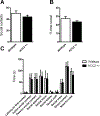Enhanced Social Dominance and Altered Neuronal Excitability in the Prefrontal Cortex of Male KCC2b Mutant Mice
- PMID: 30977597
- PMCID: PMC6499695
- DOI: 10.1002/aur.2098
Enhanced Social Dominance and Altered Neuronal Excitability in the Prefrontal Cortex of Male KCC2b Mutant Mice
Abstract
The K-Cl cotransporter KCC2 is essential in the development of the "GABA switch" that produces a change in neuronal responses to GABA signaling from excitatory to inhibitory early in brain development, and alterations in this progression have previously been hypothesized to play a causal role in autism spectrum disorder (ASD). We investigated the KCC2b (Slc12a5) heterozygous knockout mouse using a battery of rodent behavioral tests relevant to core and comorbid ASD symptoms. Compared to wild-type littermates, KCC2+/- mice were normal in standard measures of locomotor activity, grooming and digging behaviors, and social, vocalization, and anxiety-like behaviors. However, KCC2+/- mice exhibited increased social dominance behaviors and increased amplitude of spontaneous postsynaptic currents in the medial prefrontal cortex (PFC) that were previously implicated in governing social hierarchy and dominance behaviors. Treatment of wild-type mouse brain slices with the KCC2 inhibitor VU0240511 increased the amplitude and frequency of excitatory postsynaptic currents, partially recapitulating the phenotype of KCC2+/- mice. These findings indicate that the activity of KCC2 plays a role in social dominance, in parallel with effects on PFC signaling, further suggesting that KCC2 function has some relevance to social behavior but without the breadth of impact on autism-like behavior suggested by previous studies. Further testing could assess whether KCC2 alters other circuits and whether additional factors such as environmental insults may precipitate autism-related behavioral phenotypes. Autism Research 2019, 12: 732-743. © 2019 International Society for Autism Research, Wiley Periodicals, Inc. LAY SUMMARY: A mouse model of altered chloride transporter expression was used to look for a role in behaviors and brain function relevant to autism. There was an imbalance in signaling in the prefrontal cortex, and increased social dominance behavior, although other autism-related behaviors were not changed. These findings indicate that altered chloride transporter function affects prefrontal cortex function and social dominance without a broader impact on autism-like behaviors.
Keywords: GABA; autism; dominance; excitatory; inhibitory; social.
© 2019 International Society for Autism Research, Wiley Periodicals, Inc.
Figures






References
-
- Amadeo A, Coatti A, Aracri P, Ascagni M, Iannantuoni D, Modena D, … Becchetti A (2018). Postnatal Changes in K(+)/Cl(−) Cotransporter-2 Expression in the Forebrain of Mice Bearing a Mutant Nicotinic Subunit Linked to Sleep-Related Epilepsy. Neuroscience, 386, 91–107. doi:10.1016/j.neuroscience.2018.06.030 - DOI - PubMed
Publication types
MeSH terms
Grants and funding
LinkOut - more resources
Full Text Sources
Molecular Biology Databases
Miscellaneous

